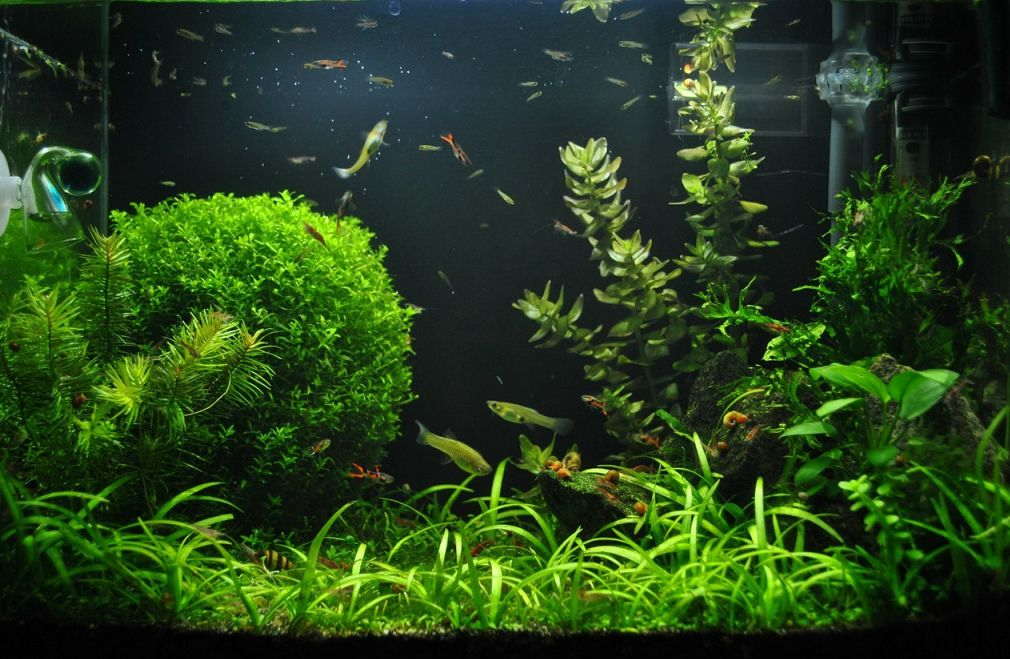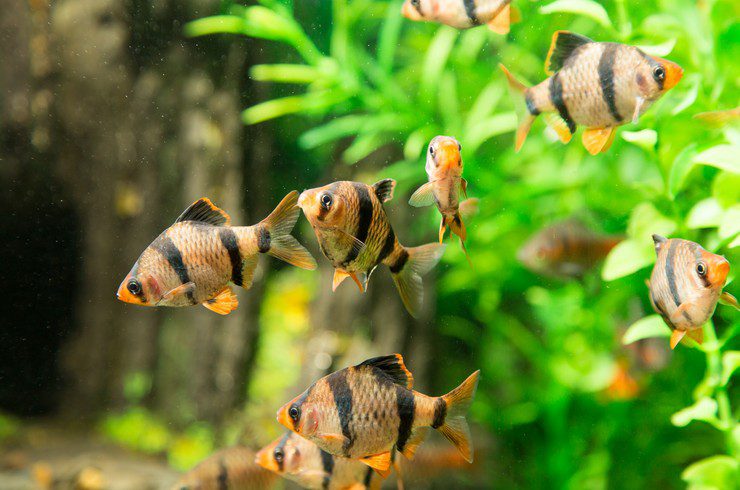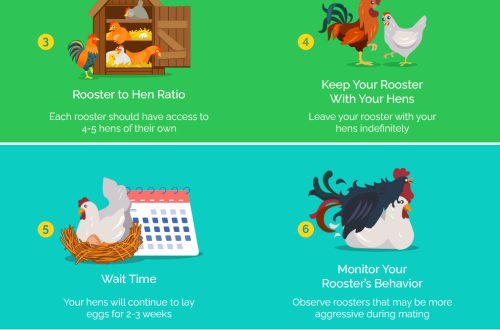
Unpretentious aquarium plants: their names and descriptions, conditions of detention
The idea to decorate your aquarium with live plants visits every aquarist. In the world there are a huge number of plant species that adapt to the conditions of the aquarium. But in order to achieve extraordinary landscaping and a fabulous landscape, you need to be able to correctly combine them with each other, taking into account compatibility and harmoniously place them in the underwater space of the aquarium.
A wide range of aquarium flora makes it possible to realize a variety of design finds. In creating an underwater garden, all the constituent characteristics of plants, such as shape, color, growth characteristics, are important. The Internet is replete with beautiful pictures, and the head is spinning from emerging ideas, so many are seized by the desire to do something similar in their own aquarium and they run to the market. There, the novice aquarist opens rich selection of plants, and sellers vying with each other offer their goods, advising and persuading. As a result, a happy buyer returns home with a decent amount of water spreads.
Having placed the purchased plants in his aquarium, the novice aquarist enjoys the beauty created by his own hands for seven whole days, after which problems begin. In one plant, the leaves dissolved, on the other, a brown coating began to form, in the third, the roots begin to rot. After studying the situation, it turned out that inexperienced aquarist bought capricious plantsthat require bright lighting, special CO2 supply and other conditions. The newcomer was simply not ready for this, in addition, half of the plants turned out to be “non-aquatic”, that is, unsuitable for life under water. (That’s how the sellers …)
Unfortunately, only unsuccessful attempts can bring the realization that growing a garden in an aquarium is not as easy as previously thought, and some experience is needed to successfully grow underwater plants. Best for beginner aquarists for breeding suitable for “simple” aquarium plantsthat do not require special conditions.
Contents
hardy aquarium plants
Hornwort
- belongs to the hornwort family, prefers ponds with stagnant or slow-flowing water;
- it has an elongated stem and whorled leaf arrangement, the leaf is palmately compound;
- the plant has no roots, so it can be freely allowed to “swim”, and also planted in a group in the ground in the middle or background;
- lighting ranges from 0,3-0,4 W / l;
- water temperature should be in the range from 16 to 28 degrees;
- The plant propagates by cuttings.
The hornwort grows in moderately warm latitudes of the entire planet. The leaves are needle-shaped dark green, the stem is long reddish. For aquarium lovers plant is popular, as it is very unpretentious and grows quickly. Just like in nature, in an aquarium there is a seasonality in the growth of hornwort. During the winter period, its growth slows down, it sinks to the bottom, retaining only the apical shoot.
Any aquarium is suitable for hornwort: cold, warm temperate or tropical. High water temperature (24-28 degrees) contributes to the rapid development of the plant. He likes moderately hard water with a neutral or slightly alkaline reaction. But it also tolerates soft water with an acidic reaction – in it it grows somewhat worse. hornwort requires frequent water changes, since particles of turbidity settle on the leaves and spoil the appearance of the plant, while it tolerates the appearance of plaque quite steadily. Contaminated areas should be pulled out and rinsed under running water, then re-placed in the aquarium.
Despite the fact that the plant has a dark color, it is quite photophilous, so you should be careful about its illumination. The most useful will be natural diffused light. Direct sunlight for the hornwort is undesirable. Algae rarely grow on its leaves.
Artificial lighting should be bright enough. For this incandescent lamps are used, as well as luminescent type LB with a power of at least 0,3 W per liter of water volume. The plant under artificial light looks somewhat pale compared to natural light. Light day should be long, at least 12 hours.
Hornwort does not need mineral supplements. It does well with the nutrients coming from fresh water and fish food. Its root system is undeveloped and does not play a significant role in nutrition, therefore it can be grown in a floating state or planted in the ground.
When autumn comes, when the lighting falls, the plant slows down its growth, sinking to the bottom. If the water temperature is high and artificial lighting is maintained, the hornwort grows for quite a long time, but a dormant period still cannot be avoided. It retains only the tops when the temperature drops to 12-14 degrees, in the spring new stems develop from them. Grass easy and fast breeding stem division. To get a new plant, it is enough to have a small piece of the stem.
Hydrocotyl white-headed
Another name is the white-headed shieldwort. This is a natural plant widely distributed in stagnant and flowing waters tropical regions of South America. Reputed to be an original plant with a long stem and light green rounded leaves up to 4 centimeters in diameter. White-headed scutellum stretches up to 50 centimeters. It is a hardy and fast growing plant.

Hydrocotyl griffon prefers a tropical aquarium. It takes on a very attractive appearance when planted in the background of the aquarium. Growing in the ground, it quickly occupies the surface of the water, creeping along it, thereby creating a shadow for the entire underwater world of the aquarium. In order for the rest of the plants to receive the light they need, the resulting carpet needs to be thinned out from time to time. The pennywort can be used as a floating plant and not rooted in the ground, then it becomes a good refuge for fry. Hydrocotyl grows well in aquariums of any size.
The white-headed hydrocotyl does not require special conditions for keeping. Water temperature of 22-28 degrees is optimal. The hydrocotyl responds to a lower temperature by cessation of growth. Water hardness, as well as its active pH reaction, do not affect the plant. It thrives in both alkaline and acidic environments. The most optimal pH parameters are 6-8. Needs regular water changes, in old, stagnant water the plant can quickly degrade. The nature of the soil for the white-headed shieldwort does not matter.
Reproduction of hydrocotyl occurs due to cuttings. If conditions are favorable, then an adult plant is able to grow from a small segment of the stem with one leaflet.
Hygrophila polysperma (Indian)
- another name Bolotnik;
- belongs to the acanthus family, native to Southeast Asia;
- grows in regions with a warm climate in swamps and in water;
- the stem of the swamp is elongated, erect, sometimes creeping. The leaves are opposite. Pinnate venation. Flowers are formed in the axils of the leaves, which are above the water;
- grown in a group in nutrient soil;
- water temperature from 24 to 28 degrees, medium pH 6,5-7,5.
This representative of the flora is often called the “Indian star”. She is very popular with aquarists, has a long stem and oval light green leaves. Its stems can be very long. Hygrophila looks good in the background in aquariums of different sizes. There it grows evenly throughout the year.
The Indian asterisk is kept in a tropical aquarium, the temperature regime is 24-28 degrees. If the water temperature drops below 22 degrees, then the plant slows down its growth. Hygrophile needs regular water changes. It should be soft and slightly acidic. If the stiffness is more than 8, then the growth of the plant deteriorates, the upper leaves become smaller, and the lower ones fall apart.
The need for bright lighting is indicated by the light green color of the leaves. Lighting can be natural or artificial. Direct the sun’s rays are undesirable for the swamp, so it is better to darken the plant. Artificial lighting can be arranged using fluorescent lamps (LB type), as well as incandescent lamps. Fluorescent lamps should have a power in the range of 0,4-0,5 W per liter of water, and incandescent lamps should be three times more. Light day should last at least twelve hours. Signs of a lack of light can be leaf shredding and stem overgrowth.
The soil for growing multi-seeded hygrophila is slightly silted, may consist of coarse sand or very small pebbles. Plant does not need additional feeding, he lacks natural sludge. If your aquarium garden has a lot of plants and they grow quickly, then you need to make complex mineral fertilizers. For 10 liters of water, 2 g of fertilizer is applied, subject to weekly water changes.
Bogweed is easily propagated by stem cuttings. To do this, you need to take a part of the stem with five muddy leaves and immediately plant it in the ground. The root system develops rapidly when the two lower leaves are deepened.
It is undesirable to let the hygrophila “swim” because the root system actively absorbs substancescoming from the ground. Without planting, the plant develops very poorly, growth slows down, and the leaves become smaller.
The multi-seeded hygrophila, like its other species, is successfully grown in a humid greenhouse and in a paludarium. In the air, on a nutrient substrate and in bright light, it will not be difficult to grow a plant, in such conditions it develops very quickly.
Shinersia tamed
- another name is Mexican oak. Family – Compositae. The natural habitat is Northern Mexico, Texas.
- grows both under water and above the surface of the water in rivers or streams with a slow current.
- grows quite quickly, reaching a height of 40-70 centimeters.
- for the best well-being, the plant needs optimal water temperatures from 18 to 30 degrees, the acidity of the water is pH 6,0 – 8,0.
Shinersia has a large or medium stem. Underwater leaves can reach a length of up to 7,5 centimeters, a width of 3,5 centimeters, on the reverse side they are lanceolate, cross-opposite, depending on the brightness of the light, they can have a color from green to reddish-brown, they look like oak leaves. On the water surface of the Mexican oak, tubular flowers form.
Shinersia tamed is growing rapidly, unpretentious. The water is soft to medium hard. Propagated by cuttings. Can look great in the middle or background of an aquarium as a group.





